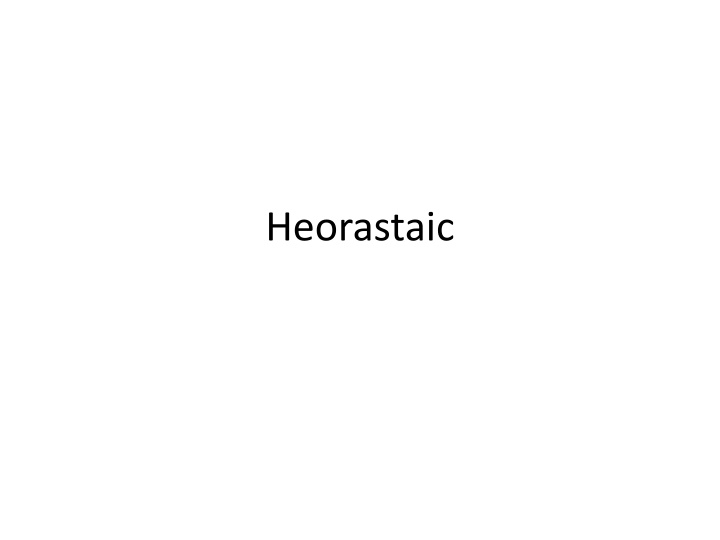
Heuristic Algorithms for Pathfinding in Computer Science
Explore the concepts of heuristic algorithms like the A* search algorithm and Dijkstra's shortest path algorithm in the field of computer science. Discover how these algorithms efficiently find the shortest path from starting nodes to destinations, optimizing travel and problem-solving in various applications.
Download Presentation

Please find below an Image/Link to download the presentation.
The content on the website is provided AS IS for your information and personal use only. It may not be sold, licensed, or shared on other websites without obtaining consent from the author. If you encounter any issues during the download, it is possible that the publisher has removed the file from their server.
You are allowed to download the files provided on this website for personal or commercial use, subject to the condition that they are used lawfully. All files are the property of their respective owners.
The content on the website is provided AS IS for your information and personal use only. It may not be sold, licensed, or shared on other websites without obtaining consent from the author.
E N D
Presentation Transcript
LO 1.10 A phl cathain ba ch ir agus a d fh adfa cur chuigeheorast il a s id agus m ni a thabhairt ar na teorainneacha a bhaineann le cur chuige heorast il a s id
Heorastaic halgartaim Faigheann siad freagra maith don fhadhb Oibr onn siad go tapa N fhaigheann s an freagra is fearr Heorastaic Neas ch n
Rogha comhritigh 1. Barrmhaitheas: An bhfuil s t bhachtach an freagra is fearr a aimsi ? An bhfuil neas ch n ceart go leor? 2. Comhl ine: An f idir leo na freagra go l ir a aimsi ? An bhfuil na freagra go l ir ag teastail? 3. Cruinneas: Cad an earr id? 4. Aga rite: An bhfuil an modh seo n os tap la n n os moille n na modhanna traidisi nta?
Travelling salesman problem Tosa onn t sa bhaile Cr ochna onn t sa bhaile Tugann t cuairt ar gach baile d reach uair amh in Cr ochnaigh do thuras san am is giorra
Dijkstras Shortest Path algorithm agus an A* Search Algorithm An bealach is giorra A go Z
Start by setting the starting node (A) as the current node.
Check all the nodes connected to A and update their Shortest Distance from A and set their previous node to A . Update their total distance by adding the shortest distance from A and the heuristic distance to Z.
Set the current node (A) to visited and use the unvisited node with the smallest total distance as the current node (e.g. in this case: Node C). Check all unvisited nodes connected to the current node and add the distance from A to C to all distances from the connected nodes. Replace their values only if the new distance is lower than the previous one. C -> D: 3 + 7 = 10 < Change Node D C -> E: 3 + 10 = 13 < Change Node E The next current node (unvisited node with the shortest total distance) could be either node B or node D. Let s use node B.
Check all unvisited nodes connected to the current node (B) and add the distance from A to B to all distances from the connected nodes. Replace their values only if the new distance is lower than the previous one. B -> E: 4 + 12 = 16 > 13 Do not change Node E B -> F: 4 + 5 = 9 < Change Node F The next current node (unvisited node with the shortest total distance) is D.
Check all unvisited nodes connected to the current node (D) and add the distance from A to D to all distances from the connected nodes. Replace their values only if the new distance is lower than the previous one. D -> E: 10 + 2 = 12 < 13 Change Node E The next current node (unvisited node with the shortest total distance) is E.
Check all unvisited nodes connected to the current node (E) and add the distance from A to E to all distances from the connected nodes. Replace their values only if the new distance is lower than the previous one. E -> Z: 12 + 5 = 17 < Change Node Z
We found a path from A to Z, but is it the shortest one? Check all unvisited nodes. In this example, there is only one unvisited node (F). However its total distance (20) is already greater than the distance we have from A to Z (17) so there is no need to visit node F as it will not lead to a shorter path. We found the shortest path from A to Z. Read the path from Z to A using the previous node column: Z > E > D > C > A So the Shortest Path is: A C D E Z with a length of 17
Sampla R omhaire ag imirt fichille Marga ocht C rais GPS agus Google Maps An madra rua agus an gh
